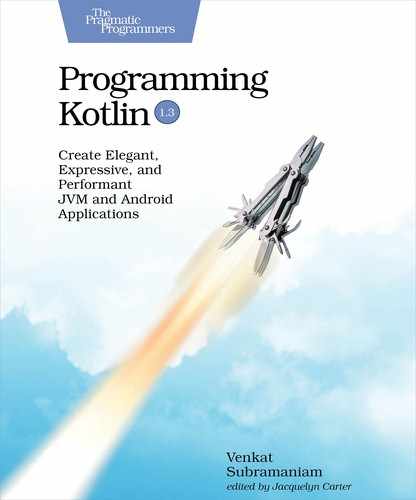Creating a Starter Project
The easiest way to get started is using the Spring Initializr[38] website. We’ll create a Spring Boot RESTful web service that stores data in the in-memory H2 database.
Once you visit the Spring Initializr website, choose either Maven Project or Gradle Project. For language, select Kotlin, of course. Then choose the desired version of Spring Boot—for the examples in this chapter, we use version 2.1.2. For the Group text box, type a desired top-level package name—for example, com.agiledeveloper. For the Artifact, type todo. In the text box next to Search for Dependencies, type “Web” and select it from the drop-down list that appears. Also, type “H2” and select it from the drop-down. As a final dependency, type “JPA” and select it from the drop-down. Finally, click the Generate Project button and save the generated zip file to your system.
Unzip the todo.zip file on your system and, using the command-line tool, cd to the todo directory.
Examine the pom.xml file if you selected a Maven project, or the build.gradle file if you selected Gradle instead. Take note of the dependencies. You’ll see dependencies on the H2 library, the Jackson-kotlin library, which will be used to create a JSON response, the JPA library, and the Kotlin-stdlib library compatible with JDK 8.
Spring Boot uses a special Kotlin-Spring compiler plugin to deal with a few things that conflict with the default Kotlin way and the Spring way. In Kotlin, classes are final by default. But Spring expects classes to be open. Without the Kotlin-Spring compiler plugin integration, each class written using Kotlin, like a controller, for example, will have to be explicitly marked open. Thanks to the plugin, we can write the classes without the open keyword. The plugin will inspect a class to see if it has some Spring-related meta-annotations, like @Component, @Async, @Transactional, and so on, and if it does, it’ll automatically open those classes during compilation. Since these are meta-annotations, in addition to opening classes that are decorated with these annotations, the plugin also opens classes that are decorated with derived annotations like @Component.
The entry point for a Spring Boot application is the class containing the main() method. If we were to create the Spring Boot application using Java, we’d have something like this:
| | //Java code only for comparison purpose |
| | package com.agiledeveloper.todo; |
| | |
| | import org.springframework.boot.SpringApplication; |
| | import org.springframework.boot.autoconfigure.SpringBootApplication; |
| | |
| | @SpringBootApplication |
| | public class TodoApplication { |
| | |
| | public static void main(String[] args) { |
| | SpringApplication.run(TodoApplication.class, args); |
| | } |
| | } |
You know that Kotlin is a language of low ceremony, and we don’t need a class to create the main() function in Kotlin. The Spring Initializr tool created a much simpler file for our Kotlin version of the application:
| | package com.agiledeveloper.todo |
| | |
| | import org.springframework.boot.autoconfigure.SpringBootApplication |
| | import org.springframework.boot.runApplication |
| | |
| | @SpringBootApplication |
| | class TodoApplication |
| | |
| | fun main(args: Array<String>) { |
| | runApplication<TodoApplication>(*args) |
| | } |
The Java version and the Kotlin version of TodoApplication have three differences between them: First, the main() function in the Kotlin version is a standalone top-level function, instead of being a member of the class. Second, the bootstrap call to SpringApplication.run() in the Java version has been replaced with a more concise, less cluttered call to runApplication()—thanks to the powerful generics facility of Kotlin, we’re able to infer the class details from the parametric type provided. The third difference is the lack of semicolon—let’s not forget that.
We’ve not written any code yet, but before we make any changes, let’s compile the downloaded starter project code and make sure it builds successfully.
If you choose to use Maven, run the following commands to build the code and to start the application:
| | $ ./mvnw clean install |
| | $ java -jar target/todo-0.0.1-SNAPSHOT.jar |
If you choose Gradle instead, then run the following commands to build the code and to start the application:
| | $ ./gradlew build |
| | $ java -jar build/libs/todo-0.0.1-SNAPSHOT.jar |
Refer back to the above commands anytime you want to build the application.
We have the starter code in place. Our application will manage tasks where each task has a description. We’ll have three routes, all through the endpoint task, but with three different HTTP methods:
- GET method to list all available tasks.
- POST method to add a new task.
- DELETE method to remove an existing task.
Let’s now move on and write some code for the application at hand.
